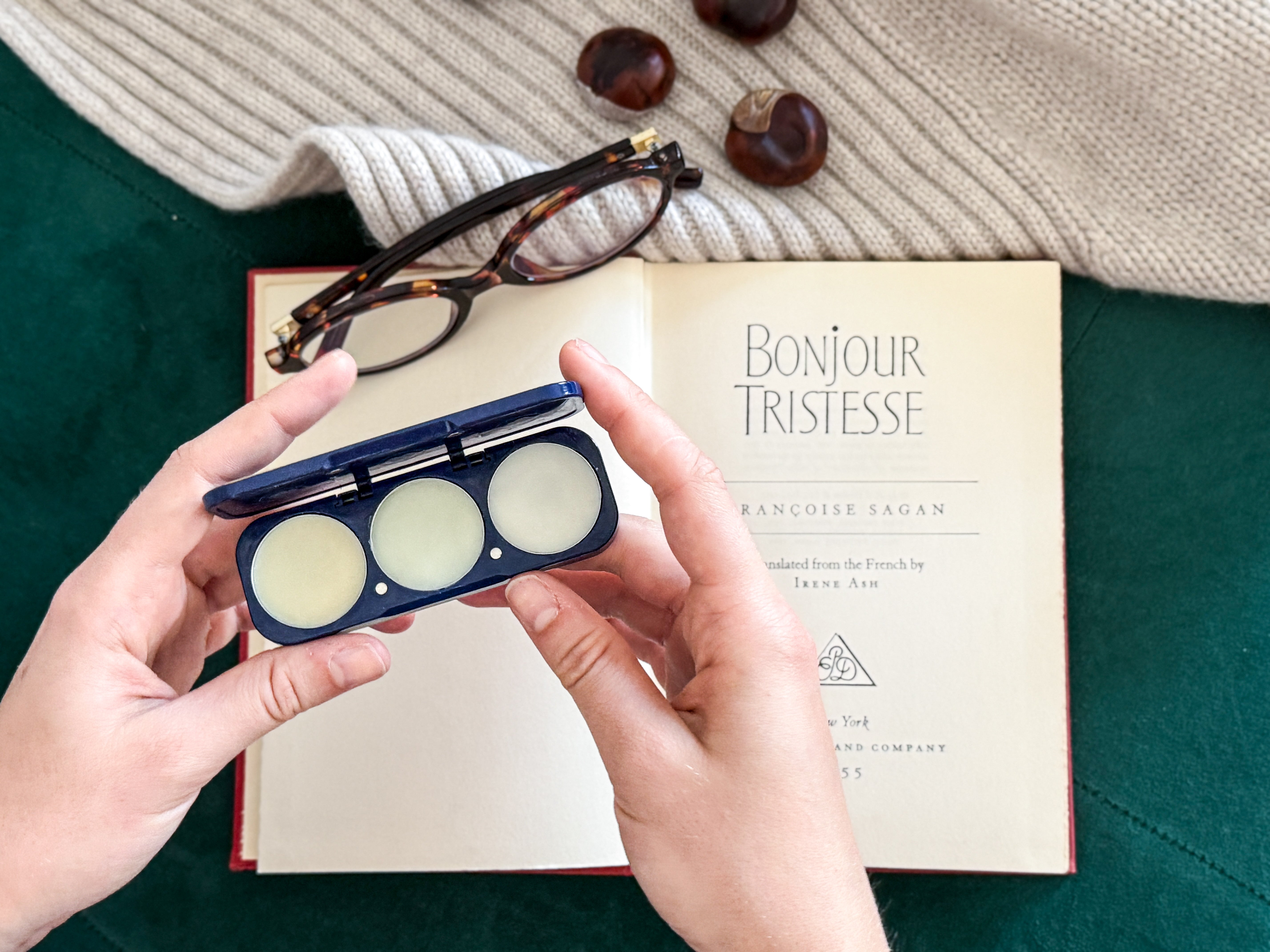Learn how to layer fragrances and create your own signature scent. Discover rules, pairings, and why ēma solid perfumes make layering effortless.

“Fragrance is the first layer of dressing, a woman’s invisible body suit.” Donna Karan
Fragrance Layering for Beginners
Perfume is personal. It lingers on your skin, in your hair, on your favorite sweater, and in the memories of the people you meet. For many, finding “the one” signature scent feels like an impossible quest - too floral, too heavy, too sweet, too fleeting. But here’s the secret: you don’t need to find the perfect perfume in a single bottle. You can create it yourself.
This is where fragrance layering comes in. Also known as scent layering or perfume cocktailing, layering gives you the freedom to combine multiple fragrances into a blend that feels uniquely yours. With the right approach, you can design a scent wardrobe that works for every mood, every season, and every occasion.
In this guide, we’ll break down the basics of fragrance layering and show you how to craft your own signature scent.
Why Layer Fragrances?
Personalization
Fragrance layering allows you to create a scent no one else has. Your blend is tailored to your tastes, your body chemistry, and your mood.
Versatility
Instead of sticking to one perfume, fragrance layering gives you multiple combinations from just a few fragrance notes. Think of it as having a capsule wardrobe for scent.
Creativity
Mixing fragrance notes and perfumes is an art. Once you start experimenting, you’ll discover endless possibilities.
Mood-Boosting
Fragrance has the power to shift energy and emotions. Want to feel energized in the morning? Layer bright citrus and green notes. Need calm in the evening? Blend lavender and warm woods.

The Basics of Fragrance Structure
Before you start fragrance layering, it helps to understand how fragrances are built. Most perfumes are composed of three layers, often called the fragrance pyramid:
Top Notes: The first impression—fresh, light, and fleeting (citrus, herbs, light fruits).
Heart Notes: The “true” character of the fragrance, unfolding after the top fades (florals, spices, green notes).
Base Notes: The longest-lasting, grounding elements (woods, resins, musks, vanilla).
When you layer, you’re essentially playing with these categories to find harmony.

The Golden Rules of Fragrance Layering
-
Start Simple
Begin with two fragrances rather than piling on many. A simple duo often smells more refined than a complicated blend. Match Strengths
Don’t mix a delicate citrus with a very heavy oud; you risk overpowering one. Instead, layer scents of similar intensity.Think of Texture
Just like in cooking, fragrances have texture. Florals can be light and airy, vanillas smooth and creamy, woods deep and smoky. Pairing contrasting textures can be magical if balanced.Test on Skin, Not Paper
Fragrance reacts with body chemistry. Always test your layering combinations on your skin to see how they evolve.Less Is More
A touch of solid perfume on pulse points is often enough. Over-application can muddy the scent.
Why Solid Perfumes Make Layering Easier
Traditional spray perfumes can be messy to layer—they’re strong, alcohol-based, and not easy to control. That’s why solid perfumes are ideal for experimentation.
Precision: You can apply exactly where you want—wrists, neck, behind ears.
Blendable Texture: Solids can be mixed directly on skin, creating a smooth fusion of scents.
Portable: Toss them in your bag for re-layering throughout the day.
Subtle Strength: They don’t overwhelm, making layering more elegant.
At ēma, our refillable solid perfume compacts were designed with layering in mind. With curated fragrance pods—from fresh neroli to deep amber—you can swap scents, mix and match, and build a collection that evolves with your life.


Common Mistakes to Avoid
- Overdoing It: Two to three layers are usually enough. Too many notes can clash.
Ignoring Seasonality: Heavy gourmands may feel suffocating in summer. Light citruses may disappear too quickly in winter. Adjust your blends to the season.
Mixing Clashing Families: For example, sharp aquatic scents rarely sit well with sweet gourmands. Always test before committing.

Putting It All Together
Layering fragrances isn’t about following rigid rules—it’s about curiosity, creativity, and self-expression. When you discover a blend that feels like you, it becomes more than a perfume. It becomes your invisible signature, a scent people associate only with you.
Instead of searching endlessly for the perfect bottle, start with a few fragrance notes you love and let layering guide you. Soon, you’ll have a collection of personalized blends—one for work, one for weekends, one for travel, one for romance.
Ready to Create Your Own Scent?
With ēma solid perfumes, you don’t need a vanity full of sprays. Our pods make layering simple, clean, and fun. Try pairing:
Vanilla + Amber for a cozy, evening-ready blend.
Neroli + Ylang Ylang for a bright daytime scent.
Vetiver + Rose for something sophisticated and unexpected.
Explore our discovery sets to start experimenting, or design your own compact with your favorite notes.
Because the best fragrance is the one you make your own.
Books to Deepen Your Knowledge of Fragrance
If you find yourself fascinated by the art of layering, you may enjoy exploring the world of fragrance more deeply. These books are a great starting point for anyone curious about perfume history, creation, and the artistry behind scent:
“Perfume: The Alchemy of Scent” by Jean-Claude Ellena
Written by Hermès’ former in-house perfumer, this book gives a poetic and practical view into how perfumes are composed, including the importance of balancing notes.“The Secret of Scent” by Luca Turin
Part science, part passion project, this book dives into the mysteries of smell and why certain blends captivate us.“Perfumes: The A–Z Guide” by Luca Turin and Tania Sanchez
An entertaining and insightful collection of reviews on hundreds of perfumes, with plenty of inspiration for discovering combinations and layering ideas.“The Essence of Perfume” by Roja Dove
Written by a world-renowned perfumer, this book blends history, storytelling, and practical knowledge of fragrance families—perfect for anyone experimenting with layering.
Adding one or two of these titles to your reading list can enrich your layering journey, helping you understand why certain combinations feel so magical.



Share:
How Hormones Change the Way You Experience Scent
Marie Antoinette’s Secret Scent: The Tuberose Scandal of Versailles